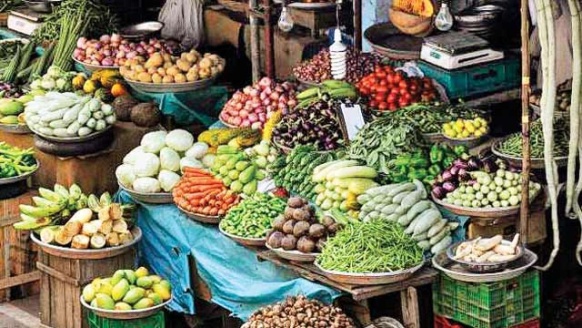RETAIL INFLATION

Disclaimer: Copyright infringement not intended.
Context
- Retail inflation accelerated sharply to 6.95% in March 2022. It marked the third straight month when inflation exceeded the Reserve Bank of India’s tolerance threshold of 6%.
Retail inflation
- Retail inflation tracked by the Consumer Price Index (CPI) measures the changes in prices from a retail buyer's perspective.
- Wholesale inflation on the other hand is tracked by the Wholesale Price Index (WPI), measures inflation at the level of producers.
Recent Findings
Reasons behind Retail Inflation
- A surge in food price inflation, which quickened to 7.68% from 5.85% in February 2022
- Rising fuel prices
- Producers passing on higher commodity prices and input costs to consumers across goods and services
Urban vs Rural Inflation
- Consumers in rural India faced a higher level of inflation than urban residents. The rural food price index sped past 8% to 8.04% in March, from February’s 5.81%.
- Poor are bearing the burden of inflation the most, given that food — which occupies the largest share of their consumption basket — recorded the sharpest rise.
Sector-wise scenario
- Transport and communication inflation, which reflects the pump prices of automobile fuels, touched 8%.
- Health costs, household goods and services, and personal care and effects saw an escalation in price pressures with inflation readings at 6.99%, 7.67% and 8.71%, respectively.
- Food and beverages inflation hit 7.47% in March.
- Edible oils and fats quickened appreciably to 18.8%
- Inflation in vegetables saw the rate almost double to 11.6%, from February’s 6.1%.
- Meat and fish prices recorded 9.63% inflation, up from 7.45% in February.
- Clothing and footwear inflation touched 9.4%, with footwear alone touching almost 11.3%.
State-wise Scenario
- Among the States, West Bengal recorded the highest retail inflation at 8.85%.
- Uttar Pradesh and Assam both clocked 8.19% inflation.
- Madhya Pradesh (7.89%), Telangana (7.66%), and Maharashtra (7.62%).
- The inflation rate stood between 7.4% and 7.6% for several other provinces, including Bihar, Jammu & Kashmir, Haryana, Jharkhand and Rajasthan.
Concerns and Implications
- Inflation pace is high and alarming emphasizing the fact that the high inflation has spread across most categories.
- This reflects build-up of price pressures in the economy due to persistent commodity price increases and amplified supply bottlenecks.
- India’s high import dependency for edible oils, fertilizers and crude oil, which are at all-time high prices globally, makes the outlook quite uncertain for inflation to dissipate soon.
- If retail inflation doesn’t significantly cool off from these levels, the central bank could opt to raise interest rates.
Consumer Price Index (CPI)
- Consumer Price Index (CPI) measures the inflation at retail level.
- Consumer Price Index (CPI) is a measure of change in retail prices of goods and services consumed by people in a given area with reference to a base year. CPI is calculated for a fixed list of items including food, housing, apparel, transportation, electronics, medical care, education, etc. The price data is collected periodically, and thus, the CPI is used to calculate the inflation levels in an economy.
- The main uses of CPI are the following:
- It is widely considered as a barometer of inflation
- Tool for monitoring price stability
- The Reserve Bank of India is now using CPI(Combined) as the as the benchmark for its monetary policy tools like Repo Rate, Reverse Repo Rate.
- According to the Agreement on Monetary Policy Framework signed between the Government and the RBI in 2015 the sole objective of the RBI is price stability and the Consumer Price Index (Combined) is measured as the target inflation.
- Consumer Price Index compiled for four groups of consumers in India:
- CPI for Industrial workers CPI(IW)
- Consumer Price Index for Urban Non-Manual Employees (UNME)
- CPI for Agricultural Labourers CPI(AL)
- CPI for Rural Labourers CPI(RL)
While the Ministry of Statistics and Program Implementation collects CPI (UNME) data and compiles it, the remaining three are collected by the Labour Bureau in the Ministry of Labour.
Inflation Targets
- Targeted consumer price index (CPI) inflation rate is= 4%
- Upper tolerance limit of inflation is= Target inflation rate + 2% = (4% + 2%) =6%
- Lower tolerance limit of inflation is= Target inflation rate – 2% = (4% – 2%) =2%
- Targeted consumer price index (CPI) inflation rate period from = April 1, 2021
- Targeted consumer price index (CPI) inflation rate period up to = March 31, 2026
Monetary policies can target inflation levels. A low level of inflation is considered to be healthy for the economy. If inflation is high, a contractionary policy can address this issue.
Must Read:
- https://www.iasgyan.in/daily-current-affairs/inflation-29#:~:text=Retail%20inflation%20based%20on%20consumer,per%20cent%20in%20February%202022.
- https://www.iasgyan.in/daily-current-affairs/monetary-policy



1.png)
